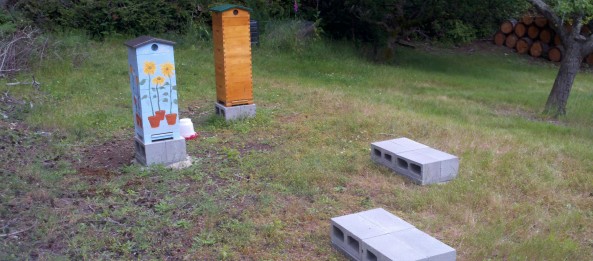On Friday a swarm came down from the sky and went into a top bar hive I was going to put a package into on Saturday. Kiva started drumming on the deck railing when she saw it swirling in the air. It quickly went into the hive. Not sure if it was already headed there or not. I spent Saturday evening and most of Sunday looking through my hives looking to see where it came from. It didn’t come from any of them.
Sunday afternoon another swarm showed up in my driveway and settled as a double clump in a fir tree. I checked all the entrances, and it also did not come from my hives. I then took the field glasses and looked at the neighbors tree. Lots of activity at that bee tree. I wonder if both swarms came from that tree?
Last year in June, I was about to set up a large colony with a cloak board for rearing queens. Unfortunately, the hive was more eager to grow queens than I. It swarmed and landed high in a tree above the apiary. The next day I watched the swarm leave and move into a hollow in a very large tree in the neighbors yard. I was saddened that the swarm left, but then realized that a WSU daughter queen just went feral in my neighborhood.
I wonder if one of the swarm queen will be marked when I check in a few days. I am also going to keep checking the sky and the trees. Maybe more previous year wayward swarms will return home.
The double clump swarm landed as two clumps and stayed as two clumps.
Usually a swarm will gather into a single clump after initially landing in a tree in multiple clumps. this one did not. Knocking two clumps of bees into buckets 15 feet straight up did not work so well. One clump went into a bucket, the other clump came raining down, oops, minor setback. All in a days fun.
Keep looking up for swarms.
George
Note: George Purkett is a key member of our bee club, West Sound Beekeepers Association. He teaches several classes and has designed this years hands on beekeeping class that over 40 beekeepers have signed up for. He posted this story on our clubs bulletin board and with his permission I’m reposting it here.
Frank


